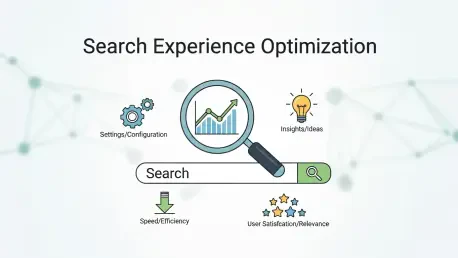Imagine a world where simply appearing at the top of search engine results is no longer enough to capture audience attention—a reality where user satisfaction dictates digital success, shaping the future of online engagement. This is the landscape of 2025, where Search Experience Optimization (SXO) has emerged as a transformative force in digital marketing. Unlike traditional Search Engine Optimization (SEO), which focused heavily on keywords and rankings, SXO prioritizes the entire user journey, ensuring visitors not only find a site but also enjoy their interaction with it. This shift reflects a broader recognition that search engines now reward engagement and satisfaction over mere visibility. This analysis dives into the evolution of SXO, its practical impact, expert perspectives, and what lies ahead for businesses navigating this trend.
Understanding the Shift from SEO to SXO
The Changing Landscape of Search Priorities
The digital search environment has undergone a dramatic transformation in recent years, driven by evolving user behaviors. Industry reports indicate that over 60% of searches now occur on mobile devices, with users expecting instant, relevant answers tailored to their needs. This demand for immediacy has pushed search engines to refine their algorithms, placing greater emphasis on metrics like bounce rates, time spent on a page, and overall engagement. As a result, websites that fail to deliver a seamless experience risk losing both rankings and audience trust, underscoring the urgency of adopting SXO practices.
Beyond mobile dominance, the rise of voice search and AI-driven assistants has further altered expectations. Users are no longer satisfied with static pages; they seek intuitive navigation and personalized content. Data from recent studies suggests that sites prioritizing user experience see up to a 30% increase in dwell time, a key indicator of satisfaction. This shift in focus from pure visibility to meaningful interaction marks a pivotal moment for marketers who must adapt to these new priorities or risk obsolescence.
Case Studies Demonstrating SXO Success
Across industries, companies are reaping the benefits of integrating SXO into their strategies. Take, for example, a leading e-commerce platform that revamped its product pages with advanced filtering options and personalized recommendations. This overhaul led to a significant 25% increase in cart completion rates, proving that a user-friendly interface can directly impact revenue. Such transformations highlight how SXO goes beyond aesthetics to drive tangible business outcomes.
In another instance, an educational website focused on accessibility by improving readability and adding interactive tools for students. The result was a marked uptick in user engagement, with return visits increasing by nearly 40%. These real-world examples demonstrate that SXO is not just a theoretical concept but a practical approach that enhances both user satisfaction and search engine performance.
A final case involves a local service business that optimized its mobile presence with clear maps, customer reviews, and streamlined booking features. This led to a surge in local search visibility and direct conversions, illustrating how SXO can cater to specific audience needs. These varied applications across sectors underscore the versatility and effectiveness of prioritizing the user journey in digital strategies.
Expert Insights on the Importance of SXO
Digital marketing leaders and user experience (UX) professionals agree that SXO represents a fundamental shift in how online success is measured. A prominent UX strategist recently noted that the integration of technical SEO with intuitive design creates a holistic approach that resonates with modern audiences. This perspective emphasizes that businesses can no longer afford to treat SEO and UX as separate entities; they must work in tandem to meet evolving expectations.
Another expert, a veteran digital marketer, pointed out the challenges inherent in this transition, such as aligning backend optimization with front-end user appeal. Balancing these elements requires a nuanced understanding of both technology and human behavior, a skill set that is becoming indispensable. The consensus among thought leaders is that overcoming these hurdles is worth the effort, as SXO has the potential to redefine key performance indicators beyond mere traffic numbers.
Experts also highlight that SXO fosters a deeper connection with audiences by focusing on satisfaction and trust. This shift in mindset, they argue, could lead to more sustainable growth compared to the fleeting gains of traditional SEO tactics. Their insights serve as a reminder that embracing this trend is not just about keeping up with algorithms but about building lasting relationships with users.
The Future of Search Experience Optimization
Looking ahead, SXO is poised to evolve alongside advancements in artificial intelligence, voice search technology, and data-driven personalization. AI tools are expected to play a larger role in tailoring search results and website experiences to individual preferences, creating interactions that feel uniquely relevant. This progression promises to deepen customer loyalty by making every digital touchpoint more meaningful and engaging.
However, this future also brings challenges, such as the need for constant adaptation to emerging technologies. Businesses will have to stay agile, continuously updating their strategies to align with innovations like voice-activated interfaces and predictive analytics. While these developments offer exciting opportunities, they also demand a commitment to ongoing learning and investment in cutting-edge tools.
The broader implications for digital marketing are significant, as SXO is likely to strengthen alignment with content marketing and social media efforts. By integrating user-focused design with authentic storytelling and interactive platforms, brands can create cohesive experiences that resonate across channels. This convergence suggests that SXO will not only shape search strategies but also redefine how marketers approach audience engagement as a whole.
Key Takeaways and Next Steps for Businesses
SXO stands as a cornerstone of modern digital marketing, transforming how brands connect with their audiences through enhanced engagement and sustainable search rankings. This trend underscores the importance of blending traditional SEO tactics with a relentless focus on user experience, ensuring that websites are not just found but also valued by visitors. The evidence from data, case studies, and expert opinions confirms that this approach yields measurable benefits, from higher conversion rates to stronger brand trust.
Businesses looking to capitalize on this shift should take steps to analyze user behavior through analytics, identifying pain points where visitors disengage. They should prioritize site speed, mobile responsiveness, and content relevance, ensuring every interaction feels seamless and purposeful. These initial efforts can lay the groundwork for more advanced SXO strategies, positioning early adopters ahead of the curve.
Moving forward, the focus should shift to experimenting with AI-driven personalization and integrating SXO with broader marketing initiatives for a unified brand presence. Companies are encouraged to view this not as a one-time fix but as an ongoing commitment to user satisfaction. By staying attuned to technological advancements and audience needs, businesses will find themselves well-equipped to thrive in an ever-evolving digital landscape.









